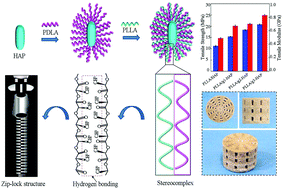Construction of a stereocomplex between poly(d-lactide) grafted hydroxyapatite and poly(l-lactide): toward a bioactive composite scaffold with enhanced interfacial bonding
Abstract
The poly(L-lactide) (PLLA)/hydroxyapatite (HAP) composite scaffold is expected to combine the favorable compatibility and processability of PLLA with the excellent bioactivity and osteoconductivity of HAP. Unfortunately, the poor interfacial bonding between PLLA and HAP leads to a deterioration in mechanical properties. In this study, poly(D-lactide) (PDLA) was grafted onto the surface of HAP nanoparticles (g-HAP), and then g-HAP was incorporated into PLLA to improve interfacial bonding by stereocomplexation in a scaffold fabricated via selective laser sintering (SLS). The results showed that HAP nanoparticles were grafted with PDLA at a grafting rate of 8.72% by ring-opening polymerization through chemical bonding in the presence of the hydroxyl groups of HAP. The grafted PDLA formed an interfacial stereocomplex with PLLA via an intertwined spiral structure ascribed to their antiparallel and complementary configuration under the action of hydrogen bonding. Consequently, the tensile strength and modulus of the PLLA/g-HAP scaffold increased by 86% and 69%, respectively, compared to those of the PLLA/HAP scaffold. In addition, the scaffold displayed good bioactivity by inducing apatite nucleation and deposition and possessed good cytocompatibility for cell adhesion, growth and proliferation.

- This article is part of the themed collections: 10th Anniversary: Dedicated Authors, 10th Anniversary: Most popular articles, 2022 Journal of Materials Chemistry B Most Popular Articles and 2023 Journal of Materials Chemistry B Lunar New Year


 Please wait while we load your content...
Please wait while we load your content...